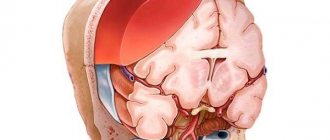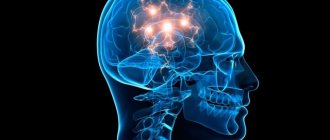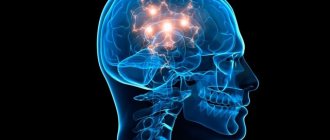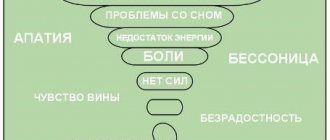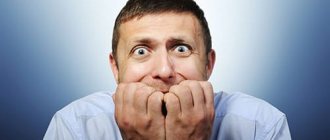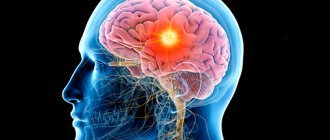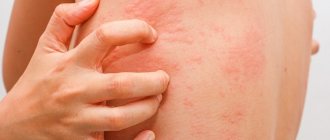Causes of the disorder
Psychomotor agitation can be an acute reaction to stress in a mentally healthy person in an extreme situation (so-called reactive psychosis). It occurs immediately after a life-threatening situation (for example, a car accident) or mental trauma. It is expressed by motor restlessness, which is often replaced by stupor.
This disorder can also be caused by:
- Acute stages of infectious diseases, accompanied by intoxication of the central nervous system with toxins of viruses or bacteria;
- Traumatic brain injuries and other brain lesions;
- Chronic and acute intoxications, including alcoholic delirium, caffeine, atropine or quinine poisoning;
- Epilepsy;
- Toxic lesions and brain hypoxia in precomatous and comatose states;
- Hysteria (as a response to an external irritating factor);
- Delirium (blurred consciousness, accompanied by figurative delirium, visual hallucinations, and a feeling of fear);
- Mental illnesses: schizophrenia, depressive psychosis, bipolar affective disorder, manic agitation.
Causes of the disease
Prolonged alcohol intoxication, alcoholism and any other intoxication can provoke agitation and aggravate it.
Some infectious diseases can cause symptoms of the described illness, but this is not common. In some professions that involve constant stress, a person may periodically become confused, but this should not be confused with agitation.
In psychiatry, agitation is one of the leading ailments. More than one and a half million people are affected by this disease every year in the United States alone.
Many patients are unable to control themselves while in this state and become dangerous to themselves and others. In view of this, in megacities, closed medical institutions or psychiatric departments are provided for such patients on one of the floors of a regular hospital.
Symptoms and types of psychomotor agitation
Depending on the clinical picture, there are many types of psychomotor agitation:
- Dysphoric: characterized by the patient’s tension, gloominess, gloominess, irritability, distrust, suicide attempts, unexpected aggression. Most often occurs with organic brain lesions and epilepsy;
- Anxious: manifested by simple movements (for example, swaying of the body) and is often accompanied by the repetition of some words or phrases, groans. Sometimes it suddenly gives way to frantic excitement (raptus), in which a person begins to rush around, scream, and hit surrounding objects. It is observed, as a rule, in depressive syndromes;
- Manic: characterized by an increased desire for any activity, high spirits, accelerated flow of thoughts;
- Catatonic: manifested by impulsive, mannered, uncoordinated, pretentious, sometimes monotonous rhythmic movements and conversations;
- Hebephrenic: this psychomotor agitation is of a foolish nature, often accompanied by meaningless impulsive actions with aggression, hallucinations, delusions, and mental automatism. Mainly observed in schizophrenia;
- Epileptiform: is a form of epileptic twilight state and is manifested by sudden onset motor agitation, which is accompanied by aggressiveness, fear, hallucinations, desire to escape, disorientation in the situation and in time;
- Psychosomatic: occurs against the background of psychopathy and other sluggish diseases (for example, with organic damage to the central nervous system, schizophrenia). The patient begins to scream, swear, threaten and show aggression towards the person with whom he has a conflict. May be dangerous to others;
- Hallucinatory and delusional: expressed by impetuous movements, intense concentration, incoherent phrases, changeable facial expressions, aggressive gestures, tension of the patient who angrily shouts threats, can insult and even hit. These types of psychomotor agitation are found in hallucinatory-delusional and delusional syndromes, sometimes with delirium. Under the influence of hallucinations or delusions, people commit unmotivated attacks (often unexpectedly) and suicidal acts;
- Psychogenic: characterized by a narrowed consciousness, insane fear, panic mood, senseless thrashing. Observed during psychogenic reactions;
- Eretic: manifested by senseless destructive actions accompanied by screams. Occurs in patients with oligophrenia.
Based on severity, there are three degrees of psychomotor agitation:
- Mild - when the patient looks unusually animated;
- Average – when a person’s actions and speech become unexpected, unfocused, he experiences severe affective disorders (sadness, anger, cheerfulness, etc.);
- Harsh – characterized by incoherence, confusion, extreme chaotic speech and movements.
Features of the course of the disorder may be due to age. Children and older people are characterized by monotony of motor and speech acts.
In old age, agitation, as a rule, has the character of fussiness, accompanied by anxiety, irritability, busy preoccupation or grumpiness.
In children, psychomotor agitation is usually manifested by monotonous crying, screaming or laughing, grimacing, swaying, stereotypical repetition of the same questions, etc. Older children, when psychomotor agitated, are constantly in motion, tear or break all objects that come to hand, they can suck their thumbs or bite their nails for a long time and persistently. Sometimes they have pathological desires, for example, elements of sadism.
Questions and answers on the topic “Nervous excitement”
Question: For several months now I have had constant increased nervous excitability. I get nervous with or without reason, and now I’m already nervous from the very fear of starting to get nervous. On the EEG: moderately pronounced general changes in bioelectrical activity. Signs of irritation of brain stem structures. How likely can we talk about organic brain damage here?
Answer: Carrying out an instrumental examination without indications and an overdiagnostic coven in the description of examination data is the path to the somatization of mental disorders and the neuroticization of the nation. General rule: EEG is needed to diagnose epilepsy. Exceptions to this rule are extremely rare. An example of an exception is suspected brain death.
Treatment of psychomotor agitation
All patients with this disorder require emergency care. In most cases, they are placed in a psychiatric hospital, since in this state they can pose a danger both to themselves and to others.
The first stage of treatment for psychomotor agitation is stopping the attack, which is carried out with the help of antipsychotics and tranquilizers: Tizercin, Chlorprothixene, Relanium, Sodium Oxybutyrate or Chlorohydrate. Next, measures are required to treat the underlying disease.
As for forecasts, it is difficult to give an unambiguous answer; it all depends on the disease or situation that caused the psychomotor agitation.
Classification and symptoms
There are several types of psychomotor agitation. If classified by severity, experts distinguish stages:
- Light. The patient is slightly animated.
- Average. The patient begins to talk a lot, sometimes illogically and unfocused. The speech is meaningless. Changes in mood are observed - unexpected joy is replaced by severe melancholy and depression. The nature of the mood change will depend on the initial cause that led to psychomotor agitation. In some patients this is an increase in mood, in others, on the contrary, it is depression.
Types of psychomotor agitation
- Spicy. The patient's actions are abrupt, incoherent, and illogical. Speech is chaotic.
Treatment
If a person develops psychomotor agitation, it is necessary to call emergency help. A psychiatrist treats this condition.
When calling an ambulance, indicate that you need a specialized mental health team. Usually she comes with the necessary medications to relieve an attack of agitation.
To prevent the patient from harming himself and others, he should be isolated from society for some time. Such patients are transported in a prone position, immobilizing them:
- The upper and lower limbs are tied separately. This is necessary so that the patient does not free himself.
- Use only soft materials - sheets, towels.
- At the fixation stage, it is important not to compress the vessels and nerves, so this matter should be entrusted to specialists.
- An immobilized person should not be left unattended.
The actual treatment is carried out on an inpatient basis in a clinical setting. To relieve signs of psychomotor agitation, various groups of drugs are used:
- antipsychotic;
- sedatives;
- tranquilizers (preferably used in elderly patients).
Medicines are administered intravenously and intramuscularly to achieve a quick effect. Neuroleptics are used in treatment:
- Aminazine;
- Clozapine;
- Levomepromazine.
Levomepromazine tablets in the treatment of the disease
The dosage is calculated individually. During therapy, constant monitoring of blood pressure levels should be carried out. If the patient has been taking these drugs for a long time, the dose may be doubled. In a hospital setting, it is possible to use small doses of anesthesia drugs (Dropyridol and Sodium Oxybutyrate).
Treatment depends on the cause of the pathological condition and is also aimed at eliminating it. For example, if we are talking about a patient suffering from schizophrenia, manic psychosis, or alcoholism.
After alleviating the patient’s condition and reducing the symptoms, therapy should be continued to achieve a lasting result.
Neurological
Eisenmenger syndrome
Alpers syndrome
Symptoms of reactive psychosis
1. Shock psychogenic reactions (shock neuroses, affective-shock reactions, emotional neuroses)
Psychosis occurs due to a sudden strong emotional shock or a life-threatening situation (accident, catastrophe, etc.), all of which can be associated with situations of a negative nature. Affective shock psychoses can manifest themselves in two forms: psychomotor retardation and psychogenic motor agitation. Psychomotor retardation with mutism. The disease manifests itself as complete immobilization and the inability to establish speech contact. The patient is unable to move or call for help, even in a potentially dangerous situation. In this condition, the patient is in clear consciousness, perceives events around him, but does not react to what is happening. Psychogenic motor agitation begins acutely, in the presence of psychotrauma. General psychomotor agitation occurs, the patient is restless, makes aimless movements, speech is usually slurred, and a grimace of horror or fear may be expressed on the face. Impaired consciousness is present.
2. Hysterical psychoses (psychogenic twilight states)
Hysterical psychoses are a common type of reactive states.
They are characterized by symptoms of any type of clouding of consciousness (disorientation, no reaction to events occurring around them, disruption of object contact, etc.). Clouding of consciousness can be traced to a connection with mental trauma. Hysterical psychoses are often divided into three types: pseudodementia, puerism, and hysterical twilight stupefaction. Pseudo-dementia
- the patient suddenly becomes “stupid”, cannot solve the simplest problems, gives ridiculous answers, and is disoriented.
Ganser syndrome is a type of pseudodementia that affects people in prison. Puerilism
is characterized by regression of the psyche to the level of a child.
The form of speech, behavior, emotional reactions become similar to children's. This clinical picture may include elements of adult behavior. Hysterical twilight states
occur in persons with hysterical psychopathy. Patients are demonstrative and can act out scenes in which there is a connection with psychotrauma. There is a perception disorder (true hallucinations), the statements are delusional, they also reflect the traumatic situation suffered.
3. Psychogenic depression (reactive depression)
Psychogenic depression is the most common form of reactive states. It is characterized by: decline in mood, feeling of depression, the patient is careless, stops taking care of himself. As depression deepens, depressive delusions (constant feelings of guilt) and often suicidal thoughts appear. The main cause of anxiety is the psychological trauma that caused the disease. The course is wavy, relative to the severity of symptoms. In clinical practice, there are three more variants of reactive depression: asthenic, depressive-delusional, hysterical psychogenic.
4. Psychogenic manias
Psychogenic manias are much less common than other reactive states. The cause of occurrence is sudden severe psychotrauma that causes a state of passion. A predisposing factor to psychogenic mania may be the presence of psychopathy of the affective and hysterical type, or schizotypal personality disorder. The clinical picture is characterized by irritability, fussiness, increased activity, and unreasonable joy. There is often a combination of opposing emotions present. A sleep disorder occurs (insomnia, restless sleep, difficulty falling asleep, shortened sleep time) associated with replaying memories of traumatic events. The patient is energetic and strives to do everything possible to improve his traumatic situation. At the peak of affect, productivity is lost, hyperactivity, importunity, and conflict come to the fore. The delirium of litigiousness and the desire to punish those “culpable” in the event may join.
5. Psychogenic paranoids
(reactive paranoid, psychogenic paranoid delusional formation, induced delusion) Reactive paranoid develops as a result of an unfavorable situation for the patient, there is a delusional belief that he is being watched, everyone around him is an enemy, treats him badly and wishes harm, etc. Auditory hallucinations often appear, which confirm the patient's beliefs. The development of an acute condition occurs after a short preceding period, with a feeling of anxiety, fear that something bad is about to happen. Psychotraumatization occurs after a new, unusual situation for the patient, combined with external impressions that create an atmosphere of anxiety, uncertainty, and anxiety.
Psychogenic paranoid delusional formation
- a type of reactive psychosis, does not have an acute onset, develops over a long period of time and gradually develops (sometimes several years). The disease is more common in individuals with paranoid psychopathy. Development occurs in conditions of chronic psychotraumatization. The delusion is systematized, based on the interpretation of real events and the situation surrounding the patient. With a prolonged course, delirium becomes persistent and persists for many years.
The patient loses the ability to work and care for himself. Memory, intelligence, adequacy and expression of emotions are not affected.
Induced delusion manifests itself in the “transition” of mental disorders from one person to another. Such a transition is observed in conditions of close communication between several individuals, while one of the individuals suffers from psychosis and is the source of induction - the inducer. A person who perceives these disorders is called inducible.
There are a number of conditions that promote psychic induction:
• close communication (cohabitation, common work or personal relationships) of the inducer and the inducible • the initial mental superiority of the inducer over the inducible (intellectual, social or characterological) • mental weakness, suggestibility of the inducible Themes of induced psychoses are most often associated with delusions of persecution, jealousy, and litigiousness.
How to provide emergency care for acute psychomotor agitation
If a person exhibits psychomotor agitation, emergency assistance is necessary immediately, since the patient can injure himself and others. To do this, all strangers are asked to leave the room where he is located.
They communicate with the patient calmly and confidently. It should be isolated in a separate room, which is first inspected: windows and doors are closed, sharp objects and anything that can cause a blow are removed. A psychiatric team is urgently called.
Before her arrival, you should try to distract the patient (this advice does not apply to the twilight state, since the patient is not contactable), and, if necessary, immobilize.
Causes of compulsive obsessive disorder
The occurrence of pathology is observed under the influence of various provoking factors. The pathological process is diagnosed in people with a genetic predisposition. At risk are suspicious people who tend to doubt and constantly double-check incoming information.
If a child was brought up within strict boundaries and his parents often forbade him to do something, then this leads to obsessive compulsive disorder. When stressful situations arise against the background of fear, the development of pathology is diagnosed. The disease appears in people who often experience nervous strain.
Use of drugs depending on the type of psychosis
As a rule, a newly admitted patient is prescribed general sedatives, but after the diagnosis has been clarified, further relief of psychomotor agitation will directly depend on its type. Thus, for hallucinatory-delusional excitation, the drugs “Haloperidol” and “Stelazine” are prescribed, and for manic arousal, the drugs “Clopixol” and “Lithium Oxybutyrate” are effective. The reactive state is relieved with the drugs "Aminazin", "Tizercin" or "Phenazepam", and catotonic agitation is cured with the drug "Mazhepril".
Specialized medications are combined, if necessary, with general sedatives, adjusting the dose.
